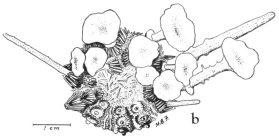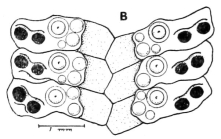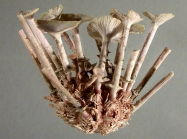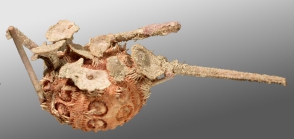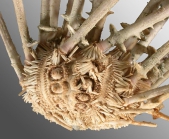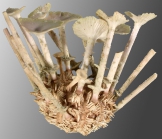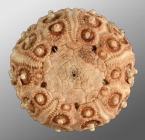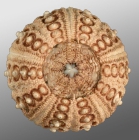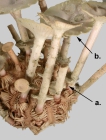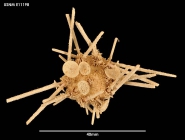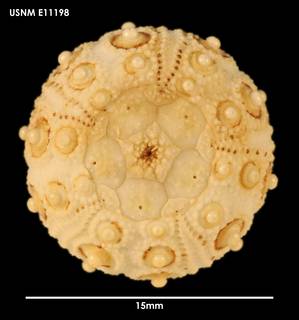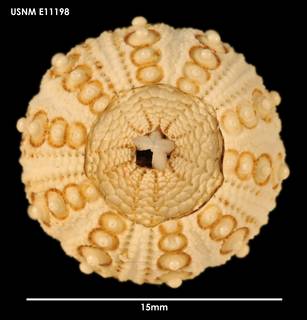WoRMS taxon details
Goniocidaris (Aspidocidaris) parasol Fell, 1958
568354 (urn:lsid:marinespecies.org:taxname:568354)
accepted
Species
Goniocidaris parasol Fell, 1958 · alternative representation
marine, brackish, fresh, terrestrial
recent only
Fell, H. B. (1958). Deep-sea echinoderms of New Zealand. <em>Zoology Publications from Victoria University of Wellington.</em> 24: 1-40., available online at http://www.nzetc.org/tm/scholarly/tei-Vic24Zool.html
page(s): 32; pl. 3: figs. B, pl. 5: fig. b [details] Available for editors [request]
[request]
page(s): 32; pl. 3: figs. B, pl. 5: fig. b [details] Available for editors
Note Station 34 (130 fathoms), Chatham Islands...
Kroh, A.; Mooi, R. (2025). World Echinoidea Database. Goniocidaris (Aspidocidaris) parasol Fell, 1958. Accessed through: World Register of Marine Species at: https://www.marinespecies.org/aphia.php?p=taxdetails&id=568354 on 2025-04-06
Date
action
by
![]() The webpage text is licensed under a Creative Commons
Attribution 4.0 License
The webpage text is licensed under a Creative Commons
Attribution 4.0 License
Nomenclature
original description
Fell, H. B. (1958). Deep-sea echinoderms of New Zealand. <em>Zoology Publications from Victoria University of Wellington.</em> 24: 1-40., available online at http://www.nzetc.org/tm/scholarly/tei-Vic24Zool.html
page(s): 32; pl. 3: figs. B, pl. 5: fig. b [details] Available for editors [request]
[request]
page(s): 32; pl. 3: figs. B, pl. 5: fig. b [details] Available for editors
 Present
Present  Present in aphia/obis/gbif/idigbio
Present in aphia/obis/gbif/idigbio  Inaccurate
Inaccurate  Introduced: alien
Introduced: alien  Containing type locality
Containing type locality
From editor or global species database
Diagnosis Test flattened above and below, the sides arched, ambitus rounded, apical system ca. half h.d., peristome one third h.d. Ambulacra weakly sinuate, ca. 16% IA. At the ambitus about seven amb plates occur opposite an IA plate. Interporiferous area 3–4 times broader than the poriferous area. Pores oblique. Marginal tubercles in vertical linear series. Internal tubercles 2 or 3 to each plate, in more or less vertical linear series. The median area is sunken, completely naked, and forms a conspicuous, vertical furrow, weakly sinuous but not following a zig-zag course, and with no abrupt changes in its width from plate to plate. About 7 IA plates. Primaries cylindrical, slender, developing a wide distal disc in the case of the adapical radioles; the disc is somewhat excentric, the adapical side being larger. In the adult, a fully-formed disc is almost as large as the apical area, and about 15 to 20 such discs may be present, forming a complete shielding system over the aboral surface. Oral primaries more or less spearhead-shaped, with lateral teeth sometimes evident near the base. [details]Type locality Station 34 (130 fathoms), Chatham Islands Expedition 1954 [details]
Type material HT: Canterbury Museum, Christchurch (H.d. 27 mm, ht. 17 mm; pl. 5: fig. b; one out of a lot of five specimens) [no specimen numbers given] [details]
To Barcode of Life (17 barcodes) (from synonym Goniocidaris parasol Fell, 1958)
To Biodiversity Heritage Library (1 publication) (from synonym Goniocidaris parasol Fell, 1958)
To NMNH Extant Collection (Goniocidaris parasol (1) E11198) (from synonym Goniocidaris parasol Fell, 1958)
To USNM Invertebrate Zoology Echinodermata Collection (6 records) (from synonym Goniocidaris parasol Fell, 1958)
To Biodiversity Heritage Library (1 publication) (from synonym Goniocidaris parasol Fell, 1958)
To NMNH Extant Collection (Goniocidaris parasol (1) E11198) (from synonym Goniocidaris parasol Fell, 1958)
To USNM Invertebrate Zoology Echinodermata Collection (6 records) (from synonym Goniocidaris parasol Fell, 1958)
